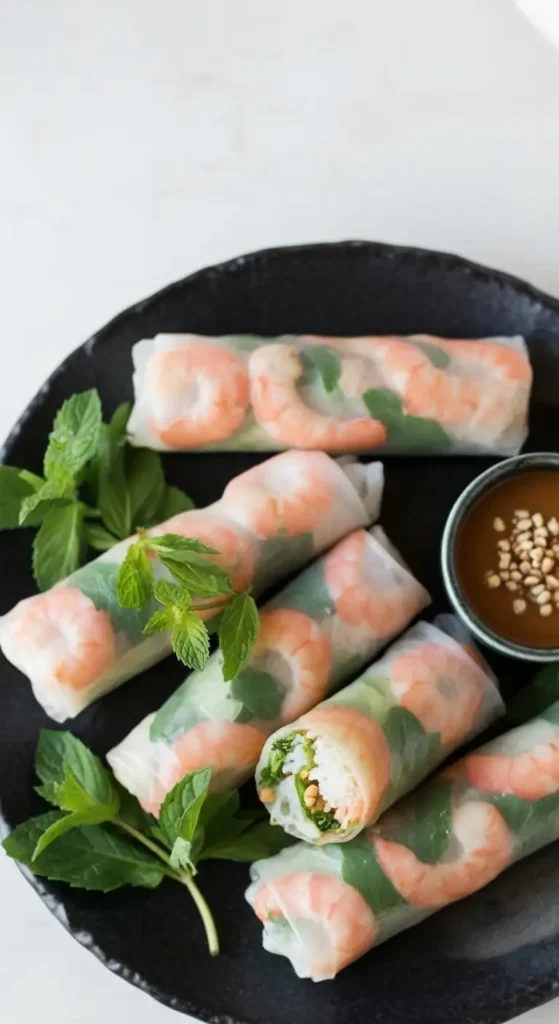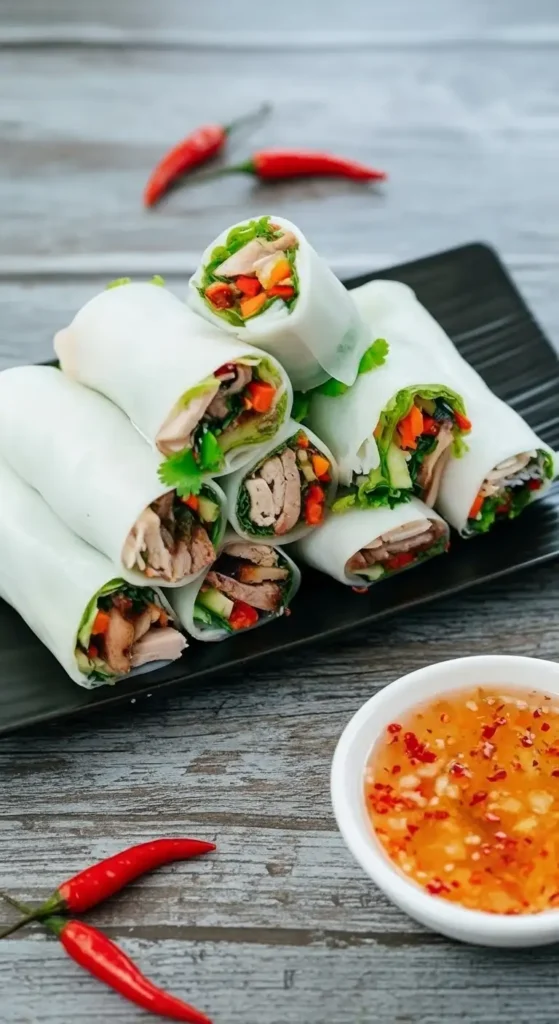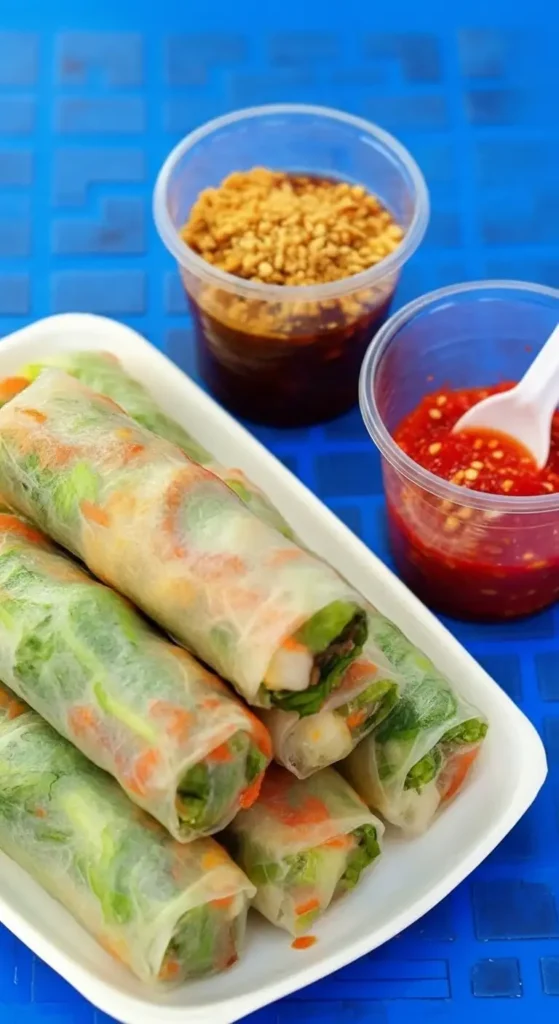Gỏi Cuốn (pronounced “Goy Kwoon”), often called “Fresh Spring Rolls” or “Summer Rolls” internationally, is the quintessential Vietnamese appetizer. Its name literally translates to “salad roll,” perfectly capturing its identity as a light, non-fried dish packed with crisp vegetables and herbs.
It is a masterpiece of texture and flavor, where cool, fresh ingredients are neatly bundled inside translucent rice paper, making it one of the healthiest and most refreshing dishes in Vietnamese cuisine.
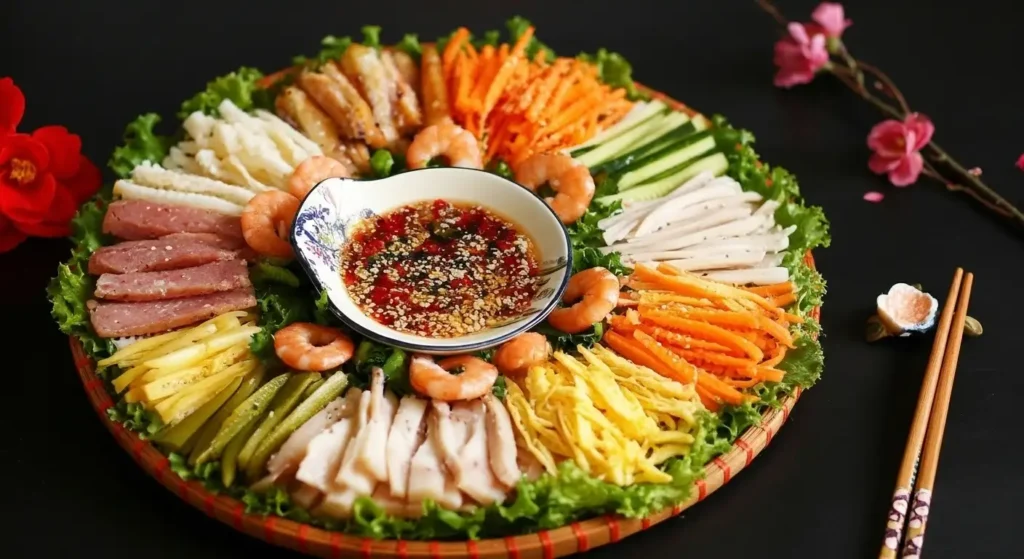
Gỏi Cuốn: The Basics
Wrapper (Bánh Tráng): The thin, translucent, chewy rice paper (made from rice flour, water, and salt) serves as the edible wrapper. Before use, the dry paper is briefly softened with water.
Core Ingredients (Gỏi Cuốn Tôm Thịt): The most common and traditional roll contains:
Protein: Slices of boiled pork belly (or leaner pork shoulder) and cooked shrimp, strategically placed so the pink shrimp are visible through the wrapper.
Starch: Bún (thin rice vermicelli noodles) to provide substance and texture.
Greens: A variety of fresh herbs (like mint, Thai basil, chives), and a leaf of lettuce or other soft greens.
Flavor Profile: Gỏi Cuốn is inherently mild and fresh, deriving its savory depth and zest from the dipping sauce, which is always served on the side.
The Experience: The act of assembling and eating the rolls is communal, emphasizing freshness, health, and the balance of cold, crisp, and chewy textures.
Varieties of Gỏi Cuốn
While the classic shrimp and pork roll is the benchmark, Gỏi Cuốn is versatile, adapting to various fillings.
| Gỏi Cuốn Type | English Translation | Key Feature & Dipping Sauce |
|---|---|---|
| Gỏi Cuốn Tôm Thịt | Shrimp and Pork Roll | The classic, served with rich Hoisin-Peanut Sauce or a light Fish Sauce (Nước Chấm). |
| Gỏi Cuốn Nem Nướng | Grilled Pork Sausage Roll | Filled with sweet and savory Nem Nướng (pork patties grilled on skewers). Usually dipped in a thick, rich sauce made from the nem nướng marinade. |
| Gỏi Cuốn Chay | Vegetarian Roll | Meat is replaced with fried or sautéed tofu, mushrooms, or seitan. Dipped in the peanut sauce or a light soy sauce. |
| Gỏi Cuốn Bò Bía | Chinese Sausage Roll (South) | A Southern specialty, featuring julienned jicama (a mild root vegetable), dried shrimp, Chinese sausage (lạp xưởng), and egg, giving it a sweeter flavor. |
| Phở Cuốn (North) | Pho Noodle Roll (Hanoi) | Not technically Gỏi Cuốn as the wrapper is a thick, uncut sheet of steamed rice noodle sheet (like a flat phở noodle) instead of dry rice paper. Filled with stir-fried beef and herbs. |
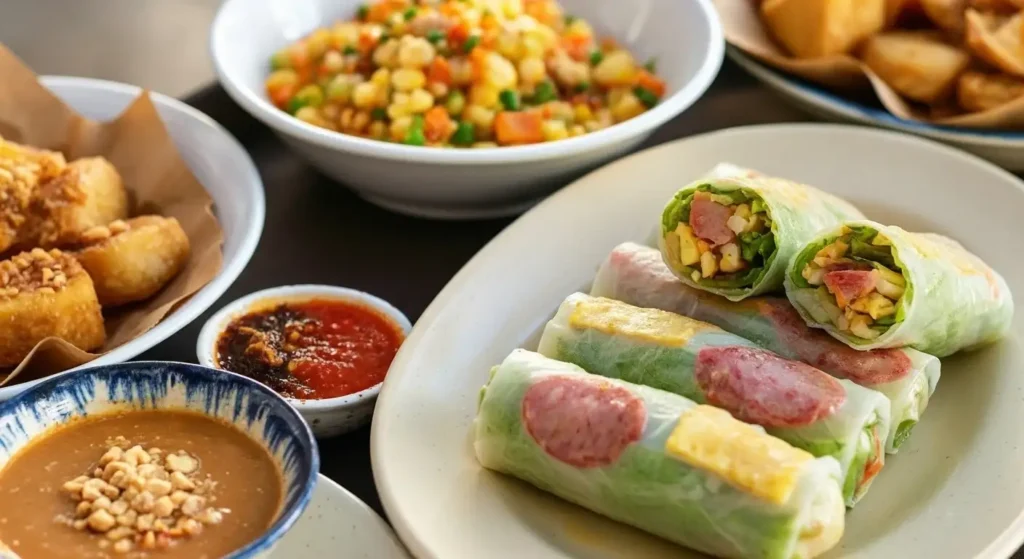
How to Eat Gỏi Cuốn
Dipping is Essential: The flavor of Gỏi Cuốn comes almost entirely from the accompanying sauce. It is rarely eaten plain.
The Two Main Sauces:
Peanut Hoisin Sauce (Tương Đen): A thick, rich, slightly sweet, and savory brown sauce made from hoisin sauce, peanut butter, and often sautéed garlic. It is typically topped with crushed roasted peanuts and chili. This sauce is most popular in the South.
Classic Fish Sauce (Nước Chấm): A light, transparent sauce that balances fish sauce, sugar, water, fresh lime juice, and chili. This tangy, savory, and spicy sauce is more common in the North and Central regions.
Bite and Dip: To eat like a local, simply grab a roll, dip the entire end into the sauce, and take a bite that includes all the fillings and the soaked sauce.
Regional Differences
The differences in Gỏi Cuốn across Vietnam are primarily seen in the preferred dipping sauce and specific fillings, reflecting the characteristic flavor profiles of each region.
| Feature | Northern Vietnam (Hanoi) | Central Vietnam (Huế, Đà Nẵng) | Southern Vietnam (Saigon/HCMC) |
|---|---|---|---|
| Core Style | Known for Phở Cuốn (Pho Noodle Rolls) more than traditional Gỏi Cuốn. The cuisine leans towards subtlety. | Spicy & Salty: The cuisine is bolder and often spicier. | Sweet & Rich: The cuisine is generous with sugar and coconut milk. |
| Dipping Sauce | Nước Chấm (Fish Sauce): Preferred. The sauce tends to be lighter, savory, and less sweet, emphasizing the fresh herb flavor. | Often uses a variation of Mắm Nêm (Fermented Fish Sauce), which is an intensely pungent, salty, and spicy sauce. | Peanut Hoisin Sauce (Tương Đen): The most common and popular choice, often made richer and sweeter than in other regions. |
| Fillings | If Gỏi Cuốn is served, it is often a very clean version (simple shrimp, pork, and herbs). Phở Cuốn (beef/herb rolls in thick noodle sheet) is the local roll specialty. | May feature local proteins like grilled pork skewers (Nem Lụi) wrapped in rice paper. | Highest variety, including Bò Bía (jicama and Chinese sausage rolls) and rolls with lots of different herbs, bean sprouts, and vermicelli. |
| Herbs | More subtle and restrained use of herbs. | A wide array of pungent local herbs are used. | Most generous with fresh herbs and bean sprouts, reflecting the region's tropical abundance. |

